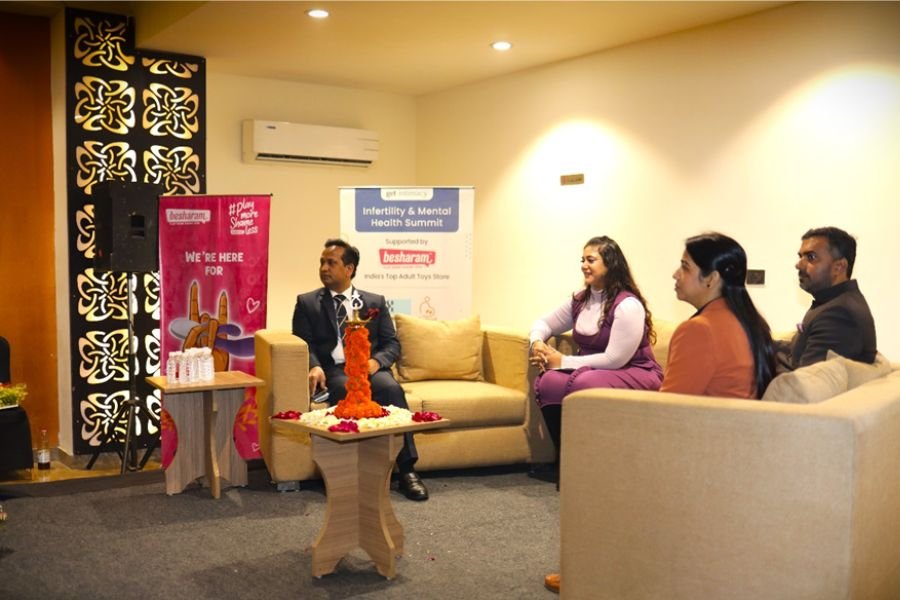
(Clockwise fm top L-R): Dr. Sangeeta Bagga, Principal, Chandigarh College of Architecture, Meenu Prashar, Architect & Interior Designer, Sumit Singla, CEO, PLPB, Lohit Bansal, MD, PLPB and an Art of Living Teacher; Egyptian Architect Omar K. Rabie & Manmohan Khanna, Founder Chairman, Chandigarh Chapter of Institute of Indian Interior Designers (IIID).
Chandigarh (India), November 29: The Architecture style of modern buildings is witnessing a paradigm shift in the Chandigarh capital region and even the country. Due to the challenge posed by global warming, and to reverse environmental damage, innovative architects have started designing buildings using ‘Bioclimatic Architecture’ techniques. This is a concept based on the local climate. Environmental resources are utilized in these buildings to ensure thermal comfort. The technique is gradually gaining momentum in the region and India to utilize local resources to create environment friendly structures.
Bioclimatic Architecture is environment friendly
Giving insights on Bioclimatic Architecture Dr. Sangeeta Bagga, Principal, Chandigarh College of Architecture (CCA), Chandigarh, says, “Since we are facing an extreme climate change, it is of utmost importance to conserve our natural resources by creating green buildings. If you understand that everything is limited, you would utilize minimum natural resources to build structures which will help save the environment. Bioclimatic architecture is bound to be ecologically safe.”
“One may give any name to the system, but staying in harmony with Mother Nature is what best describes, ‘Bioclimatic Architecture’”, opines Meenu Prashar, a Chandigarh-based Senior Architect & Interior designer.
Meenu is of the firm belief that using resources and constructing the building in an environment-friendly manner to create a microclimate inside the walls is what describes the architecture best. Meenu adds, “I am glad that the Prime Land Promoters and Builders(PLPB) group is coming up with ‘The Wellness City’ in the region, which is being constructed on the same parameters without any harm to nature.”
It is noteworthy that an upcoming township on the Chandigarh -Patiala highway – ‘The Wellness City’ is a pioneering project in the Chandigarh capital region being built using Bioclimatic Architecture techniques. Sumit Singla, CEO, PLPB, promoter of ‘The Wellness City’, informs, “Bioclimatic architecture promises compliance with every standard to ensure all-inclusive well-being of the environment. Our project is designed for the human experience and our focus is on a natural humane built environment to enhance the spiritual growth of the residents.”
Lohit Bansal, Managing Director of PLPB and an Art of Living (AOL)teacher, adds, “The idea is to build not just sustainable townships and green buildings but also cater to growth of the mind and spirit. An ‘Art Of Living’ ashram is also coming up in the premises of ‘The Wellness City.’ So the township will epitomize the values and ethos of the ‘Art of Living’, which is a philosophy of living life to its fullest.”
Supporting the need of Bioclimatic architecture, IUA awarded designer, Egyptian architect Omar K Rabie, who is designing some green buildings in the Chandigarh capital region , says, “Bioclimatic architecture gels with nature. Buildings constructed using Bioclimatic architecture offer ample natural wind, sunlight, rain, heat, humidity and other natural phenomena. It is absolutely practicable to live without using an AC or a heater in summers & winters respectively in such buildings.”
It is worth mentioning here that green buildings are well oriented with the sun and wind, and encourage favoured airflow and reduce adverse solar radiation.
Bioclimatic architecture is sustainable and sturdy:
Manmohan Khanna, Founder Chairman, Chandigarh Chapter of Institute of Indian Interior Designers (IIID) shares, “Buildings made using vernacular architecture and natural resources available within 50-100 Kms radius will be climate responsive, and that is the best architecture. Chandigarh is one of the few cities designed on this most sustainable architecture which is made for the future to offer us conducive environs besides preserving our microclimate and ecosystem.”
“Bioclimatic architecture takes into account local climate conditions and uses locally available material and resources for designing robust and climate responsive structures to ensure that there is no or minimum requirement of artificial resources to heat or cool the building, thus, minimizing the carbon footprint & impact on environment. One of its best examples is Bhunga in Kutch, Gujarat which withstood even the 2001 earthquake,” adds Pooja Sharma, a Delhi-based Senior Learning Specialist working with Livspace.
If you have any objection to this press release content, kindly contact pr.error.rectification@gmail.com to notify us. We will respond and rectify the situation in the next 24 hours.
The post Architects adopt Bioclimatic Architecture to counter climate change & reverse ‘environmental harm’ appeared first on City Lights.




